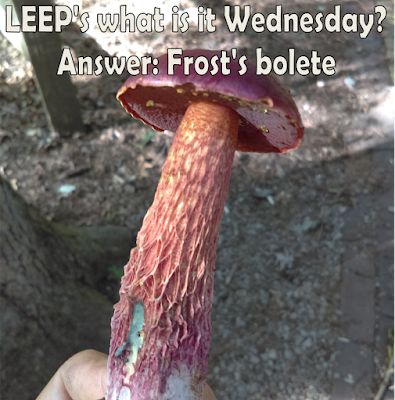Can
you identify what's in this photo?
Each Wednesday morning
on Camp Lutherlyn's Facebook page
the Lutherlyn Environmental
Education Program posts a photo.
Readers
have all morning and afternoon
to
make their best guess about what the photo is.
Around
6 pm LEEP provides the answer and a brief explanation.
Each
week's What is it Wednesday post
will
also be posted on the Nature of Lutherlyn blog,
after it is posted on Facebook,
sometimes
with additional bonus information.
In
addition to bringing you current editions of What is it Wednesday
on the
Nature of Lutherlyn blog,
we
will be reposting old editions,
creating
a What is it Wednesday archive.
This
photo was posted as a What is it Wednesday on
Septebmer 23, 2020.
And
the answer is....
These jars on the railing at Lutherlyn's Terra Dei Homestead contain the fruit
spikes
of staghorn sumac, steeping in the sun to make a lemonade-like sun-tea.
Staghorn sumac is a large shrub/small tree that produces red
plumes of seed clusters in late summer. These hairy seed clusters, when steeped
in water and then strained, make a mildly tart and refreshing drink that used
to be referred to as “Indian lemonade.” It is one of the many treats of the
late-summer abundance of the land!
In early summer, staghorn sumac develops a cluster of small
greenish yellow flowers, known as an “inflorescence.” In late summer, this
inflorescence develops into an “infructesence” – the fruit of the plant, a cluster
of seeds. (A cluster of grapes, a head
of wheat, and an ear of corn are all infructesences.) It is these red plumes that are the most
distinctive features of staghorn sumac –
and also what can be made into the delicious sumac lemonade.
 |
| by Pohled 111 https://creativecommons.org/publicdomain/zero/1.0/ |
Staghorn sumac twigs are covered with fine rust-colored
hairs, giving them a velvety texture like that of newly-grown deer antlers.
This and the branching shapes of the twigs give the shrub its common name: stag’s
horn.
Staghorn sumac is actually in the cashew family! This means
it is related to cashews, mangos, and pistachios; and also to poison ivy,
poison oak, and poison sumac. All the plants that produce urushiol, the irritant
that causes the itchy blisters of contact dermatitis, are in the same genus in the
cashew family (Toxicodendron). Staghorn sumac is in a different genus in the cashew
family (Rhus).
Many people think staghorn sumac and poison sumac are the
same thing, or aren’t sure of the differences between the two. They both are large shrubs
with compound leaves, but the similarities end there.
Poison sumac causes a strong reaction similar to poison ivy when it
makes contact with bare skin, or is eaten or its smoke inhaled, while staghorn sumac is harmless. The leaves of
poison sumac are wider and smoother and have unserrated edges; poison sumac
twigs are not hairy; poison sumac produces smaller clusters of larger flowers;
poison sumac produces white berries, not the striking red plumes of staghorn
sumac. We don’t have any poison sumac at Lutherlyn, and it is uncommon in
Pennsylvania. It is almost always found in wetlands.
 |
Poison sumac
|
Staghorn sumac is very common, has visible red plumes for
much of the year, and has hairy twigs and narrow pointy leaves with serrated
edges.
The confusion is understandable, as a lot of incorrect
information can be encountered online and passed on. I found a link to one article
on poison sumac contained a picture of staghorn sumac – but in following that
link, that picture was not included in the article at all. Only poison sumac
pictures were included in the actual article, but somehow the staghorn sumac
picture ended up in the link preview – very confusing! We are lucky that mostly what we encounter in Pennsylvania is staghorn sumac, and that it is so distinctive and with a little knowledge is easy to identify as safe.
Happy Fall, and we at LEEP hope you get to enjoy the beautiful abundance of the earth!
Like and follow Camp Lutherlyn on
Facebook, to see What is it Wednesday posts when
they come out and have the opportunity to share your guesses in the comments!
























